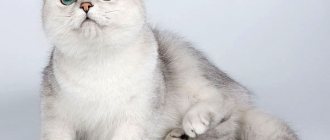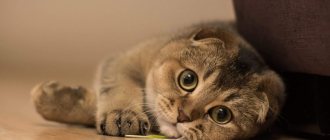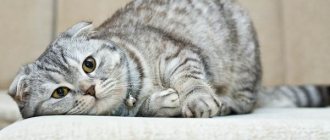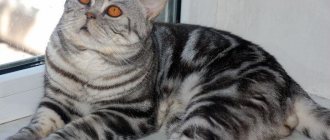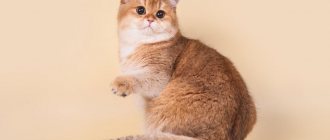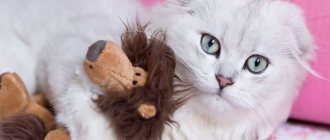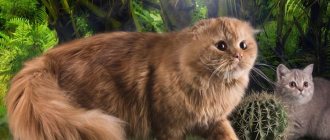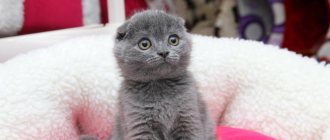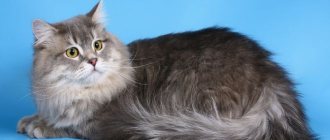The Scotch is an intelligent, moderately active cat who enjoys teasing toys, but her favorite pastime is anything that involves human interaction. The Scottish cat likes most to be in contact with its owner and take part in everything that he does. These are pets that love attention.
When talking about the Scottish cat breed, they most often mean the fold-eared version, or Scottish fold. Although in fact there are 4 varieties. But since lop-ears are the main one, the history of the occurrence of this interesting mutation began with them.
History of the breed
Scotland is considered the homeland of the Scottish, from where they quickly come to America, and then continue their march in Europe. It was American breeders who did a lot of work to secure the hanging ears. Their stud books contain all kinds of data for each representative of the breed: from nicknames to names of owners.
Numerous studies have been conducted not only on the physiology of cats, but on the genetic diseases that this ear shape brings with it.
The very first mention of the only fold-eared cat brought from China dates back to the 18th century. What happened to her later is not known for certain. Another mention of this country dates back to 1796, where a magazine describes a kitten with funny drooping ears.
The first mention in Scotland dates back to 1959, when one of the farmers saw an interesting animal among his neighbors. This was the ancestor of the whole breed - Susie, born from completely unpresentable yard cats. The white short-haired Snooks, obtained from her in 1961, becomes the next successor to the family, since the mother dies. And it is the date of her birth that is considered the beginning of breeding Scottish Fold cats.
It should be remembered that every Scottish Fold in the world is a brother or sister to another representative of the breed, since they appeared thanks to a single cat. This is why it is so important to choose the right pairs for the birth of kittens. This will help avoid further unwanted mutations, genetic pathologies and non-viable offspring.
Having received several kittens from Snooks, the Ross couple, who had previously been breeding Siamese cats, registered the Denisla cattery and began serious breeding work. They turn to geneticists to create a program to preserve the unique shape of the auricle. British cats were used in breeding, which is why these two breeds are so similar. Very little time passes and the breed is officially recognized by the English Cat Fanciers Association.
The year 1971 was marked by a ban on breeding work with these beautiful creatures. The first reason was the excessively large number of kittens born with heterochromia (white color and blue eyes), which causes deafness.
The second reason had physiological characteristics - due to the shape of the ears of representatives of the breed, it was quite difficult to cure otitis media in cats, remove ear mites, and in general, hygienic cleaning of the auricle was difficult.
Despite the fact that both problems were soon eliminated, the English Club has not recognized the breed to this day. Although a number of nurseries continue to exist and conduct breeding work in the country.
Another problem faced by Scottish breeders is the sublethal Fd gene, which is responsible for the necessary shape of the ear. As long as matings were made within the breed (low-eared and straight-eared) or the blood of other breeds was infused, the gene did not often produce side effects. But as soon as the standard was officially recognized, matings with other representatives of the breeds were stopped.
In addition, Scottish Folds began to be exported to other countries, where they tried to fix the density of the ear, which means that matings with Scots, who were born with erect ears, practically stopped. The birth of kittens began with serious anomalies of the skeletal system, which led to deformity: spinal defects, fused spinal discs, shortening of the bone, pathologies of cartilage tissue, etc. Which led to a ban on breeding Scottish cats in many countries.
Fortunately, everything turned out to be not so scary and geneticists were able to study ways of transmitting this gene. Certain rules were drawn up for breeders, which became a kind of unbreakable dogma in the Scottish cat breeding program.
The most important rule is that mating between two representatives possessing the folding gene is strictly prohibited!
But since kittens of both types (stride and fold) continue to be born in litters, this rule is quite easy to follow. The difference between these two types is only in the shape of the auricle. The Straight (a Scotsman with erect ears) has all the character traits and exterior features of the Fold (a fold-eared variety of Scottish cats).
Most often, 1-2 Fold kittens are born in a litter. But from the first day it is impossible to determine the exact number. Another characteristic feature of the Scots is that the ears begin to droop and curl only on the 21st day. Only after this can you confidently attribute each kitten to its own variety of Scots.
Scottish cat with erect ears
The ability to knit strides and folds with each other significantly affected the further history of the Scots. It is thanks to pointy-eared cats that the phenotype of the breed can be preserved.
Although single matings with British cats do occur, they are still undesirable, since the breeds differ in many ways. And they are allowed only if it is necessary to inject fresh blood and only for those animals in whose pedigree there are several generations of matings between folds.
Not every breeder can consciously agree to such conditions - too large a percentage of kittens are discarded due to anomalies. In addition, regular matings between the Scots and the British can lead to unstable hanging ears, which is a breeding marriage, and in appearance such kittens begin to look more like British cats.
That is why straights are indispensable in the breeding program of every breeder. Unfortunately, this in-breed type can only be used by breeders and as pets, since they are not allowed to participate in international exhibitions.
Despite their great popularity in the world and at home, American nurseries continue to be considered the best. It was there that simply titanic work was carried out to identify all the possible consequences of mating two homozygous Scots. It is on these results that the work of breeders in many countries is based, where it is considered a great success to get a breeding Fold cat from the USA.
Currently, this breed is recognized only by the WCF (World Cat Federation). The second no less large international Federation International Feline (FIFe) continues to ignore the popularity of folds, considering the appearance of a pathology and culling all the kittens that appear.
Intraspecific types:
- Scottish fold or fold cat. The most popular variety of Scots. Tightly fitting floppy ears, large wide eyes of a curious child, round head, soft plush fur - you want to pick her up and not let go.
- Scottish straight or straight-eared cat. Slightly smaller than Scottish and with erect ears - that’s all the difference between these two varieties.
- Highland fold or longhaired fold. A very beautiful and graceful animal. A rounded head, a strong chin, a high forehead, a powerful neck, a compact body - this cat immediately sets you up to be taken seriously. Everything is “spoilt” by wide open eyes with a curious expression and a visual absence of ears (the long hair almost completely hides them). It should be remembered that there is no longer decorative hair on the shoulders and around the neck. The hair in these places, as well as on the paws and face, is shorter.
- Highland stride or straight-eared cat with long hair. Perhaps the rarest representative of the Scottish breed. The soft, long, flowing coat is reminiscent of the hair of Angora and Persian cats, but is silkier and denser to the touch.
Maintenance and care
Straights cannot be called overly active, they will not rush around the apartment for hours and are not prone to jumping from the chandelier to the curtains, but they do not mind playing from time to time.
The owner should think about toys and gymnastic devices that you can buy or build yourself. Physical activity will help maintain a cheerful spirit and good shape throughout the pet’s life, which is especially important for cats and kittens that do not leave the apartment
Another feature of the Scots is their passion for unusual poses. Many of them like to sleep on their backs or “sit on their butts.” Without experiencing any discomfort, they can stand in columns for a long time, begging for food or a toy.
In the private sector, Scottish cats will happily walk in the garden. Here they can bask in the sun and chase flies to their heart's content. Cats usually don't go far, but unneutered cats can easily disappear for several days. It is dangerous to let out an apartment cat that is not accustomed to walking. She may get scared of something, run away and get lost.
The Scottish Straight is an exclusively domestic cat that does not require frequent walks. However, if you organize entertainment and games for him in the fresh air, a pet of any age will thank you.
This animal has a rare quality for cats - resistance to stress. Thanks to this, straight-eared Scots can easily cope with moving to a new place of residence, long trips, and a change in their usual environment. Usually they quickly and painlessly adapt to unusual conditions and get used to new faces.
Care
There is nothing difficult about caring for plush cats.
Once or twice a week they are combed, paying attention to the areas behind the ears, on the stomach and the back of the paws. Do not forget to trim the cat’s claws on time, if necessary, wipe the cat’s eyes and clean the ears.
The Scottish Straight takes any hygienic procedures calmly, especially those that are familiar from childhood, or even enjoys them. Owners of this breed often note that their pets are not only not afraid of water, but are also drawn to it, love to play with the stream or drink from the tap. You can bathe them only if absolutely necessary: if they are heavily soiled, after molting, before an exhibition.
It is important to remember that plush wool rolls very poorly and is removed from the stomach. To avoid clogging and related problems, from the age of six months the kitten is taught to take special pastes for hair removal.
If the plush coat is not brushed regularly, shedding will be noticeable. Heavy seasonal hair loss occurs twice a year and lasts for several weeks; the rest of the time, hair loss is mild or moderate.
Nutrition
Scottish cats can be fed with ready-made food, dry or with braces. A diet is selected depending on age and physiological state. You can also feed your Scotsman natural products. It is better to create a diet with a specialist, veterinarian or breeder.
Make sure that your animal's diet contains as little food as possible that is high in fat and salt. Their regular use will lead to the development of obesity in your pet, and gradually it will become lethargic and inactive.
It is important that the food meets all the pet’s needs and is healthy and balanced. A mixed diet is possible, but not recommended.
If you need to add industrial food to natural food, then it is better if it is wet food, the digestive system is already adapted to digesting it. Any changes in feeding should be gradual. Your pet must have clean water freely available, even if he prefers to drink from a tap or an aquarium.
Sterilization and castration
If breeding is not planned, it is recommended to castrate or sterilize the animal. This tactic:
- Helps you avoid health problems.
- It will have a positive effect on the pet’s character.
- Will increase life expectancy.
It is recommended to operate on a cat after puberty (8–10 months). If necessary, a female who has given birth can also be sterilized. Both male cats and female cats tolerate surgery normally at any age.
Character of Scottish Straight cats and cats
Scottish kittens are characterized by sedateness, independence and importance, at the same time they are active, inquisitive animals. They very quickly get used to a new place, among all the people living in the house
They immediately single out one person and unconditionally recognize him as a leader; a Scottish Straight cat will adore this person and follow on his heels. In the absence of people, he gets bored and always meets them at the doorstep, like a faithful dog.
With other family members, the Scots remain neutral and behave kindly; they are wary of strangers. They get along excellently with children, taking part in children's fun with pleasure. Kids, in turn, treat the charming teddy bears with delight and literally do not let go of the kitties.
However, parents should keep the situation under control, since straight-eared Scots cats cannot stand affection, squeezing, or being forced to be held in their arms, and when they break free, they can inadvertently scratch the child. They like much more to lie next to the owner, clinging to the person with their warm plush side. They rarely allow themselves to be petted and only when they want it.
Peace-loving, not at all touchy and unforgiving character, lack of aggressiveness make Scottish straight cats ideal companions for older people, and favorite pets for families with children (taking into account the points mentioned above about “cuddling”).
Straights easily find a common language with other animals living in the house: even with hamsters, even with dogs. They catch mice, and this “hunting” quality further increases the attractiveness of the breed.
Scottish Fold cats are not couch potatoes, unlike Persians, they are playful, but in moderation, they cannot be called too active, so you should not be afraid that in your absence they will cause disturbances in the house. They do not like heights and climbing curtains; exploring the wardrobes from above is not among their interests. Another thing is the inside of the closet, where a curious Scot will not hesitate to stick his charming nose.
Scottish Straight cats are not talkative; their meow can be heard extremely rarely, only if the animal is in pain or asks to be fed. More often they make peculiar sounds, reminiscent of creaking, or simply silently open their mouth.
Kittens quickly learn to use the toilet and scratching post. The last point is especially important, since straights have such a sin - they like to sharpen their claws on furniture or wallpaper.
Raising a Scottish Straight
Thanks to their innate intelligence, Scots quickly learn the rules of good manners. To get positive results it is recommended:
- Start training from the first days the pet appears in the house.
- Establish a friendly relationship with affection and treats.
- When a child tries to commit an inappropriate act, warn with a loud “No!” For greater effect, the shout is accompanied by clapping your hands.
- If the ward does not respond to strict intonation, take him by the withers and lightly shake him several times.
- Reward each pet's achievement with generous praise and treats.
Do not do it:
- Punish the young straight for excessive activity. When the baby grows up, the problem will solve itself.
- Raising a kitten with a slap and poking its muzzle into a puddle. The consequence of such techniques may be the opposite result.
- Scolding and praising the Scottish Straight retroactively. Animals are not able to establish logical connections between events on different days.
Scots are quite trainable if they want to. A playful form of exercise and your favorite treats will help you achieve good results.
Characteristics of the Scottish Fold breed (Scottish Fold)
In a nutshell, we can say that the genetics of Scots are theoretically quite simple: if one parent is fold-eared, there is a 50/50 chance of getting the same kittens. But practice shows that fewer lops are born than straights. You can recognize the sign of lop ears in kittens by about 5 weeks of age.
The Scottish Fold has relatively low maintenance and care requirements. This breed does not require special handling. To be happy, this breed requires a clean environment, plenty of food and, above all, the sympathy of its owners. Scottish Folds have a sense of humor and frolic when their owners play and laugh with him. His appearance alone already puts anyone in a good mood. The head of the Scottish Fold cat is well rounded, with a firm chin and well-developed jaws. The muzzle should have noticeable and well-rounded whisker pads. The head smoothly turns into a short, strong neck. The cheeks are well developed, especially in Scottish cats. The eyes are wide open. Large, round, widely set. Eye color generally matches coat color. The Scottish Fold has a wide nose with a slight transition. A small stop is acceptable, but a noticeable stop is considered a fault. The profile is soft, moderately streamlined. The ears are folded forward and down. Small, the smaller the better. Small, well-proportioned ears are preferred. The ears of a fold cat should be set in such a way as to emphasize the rounded skull. The tips of the ears should be rounded. The body is medium in size, rounded, in proportion to the level of the shoulders and croup. The cat is strong, densely built, but without a hint of fatness or lack of mobility due to short, rough limbs. The feet are very neat and well rounded, with five toes on the front feet and four on the hind feet. Scottish Fold cats can be slightly smaller than male cats. The tail is medium to long, but proportional to the body. The coat of the Scottish Fold is short, dense, plush, and uniform. Coat texture may vary depending on color or regional and seasonal variations. The length of the coat is medium-long to long. Abundant hair on the face and body is desirable, but short hair is allowed on the face and limbs. “Panties”, tail feathering, tufts of hair between toes and ear feathering should be clearly visible, a collar is desirable. A serious drawback of adult animals is cotton wool. The colors of the Scottish Fold can be divided into several conditional groups - solid (saturated - black, red, chocolate, lightened - blue, lilac, cream), tortoiseshell, smoky, chinchilla, patterned (tabby) and colored point In most cases, the eye color of Scottish cats should be orange or copper, but there are exceptions, for example, emerald or intense golden eyes of chinchillas and silver shaded colors, blue eyes in color point cats.
Scots colors
Plain (solid)
The coat color is uniform, without interspersing any other color. Any spots or stripes are considered a defect in a solid color.
white; black (ebony); red (deep red); blue (blue) - kittens with such gray fur most resemble a British shorthair cat; chocolate (dark brown) – a rather rare color for Scots; lilac (lavender) – a cool shade of fur, without redness; cream – warm beige color, paws and nose match the shade of the coat; fawn (light beige) – the color of the fur of a young fawn; cats of this color have soft pink paw pads and nose; cinnamon is a warm, light shade of brown, the paw pads and nose are always pink.
Bicolors (two-color)
The main color is white, it makes up from 1/2 to 1/3 of the entire body. The second color is any of the solid ones. Cats with a symmetrical pattern and color distribution are valued higher.
The most popular bicolor colors among Scottish Straights are:
Color point
Color point cats have a light body and dark face, ears and paws. The gene responsible for color is linked to blue eye color.
Blue point - blue spots. Lilac point – lilac shades. Seal point is a Siamese with black markings. Choklit point - chocolate markings. Red point - red shades.
Tortoiseshells
Tortoiseshell color is usually red, black and white spots unevenly distributed on the main color of the coat, which, under the influence of the genes of the parents, can take on blue, cream, chocolate and red shades. Tortoiseshell colors are conventionally divided into 3 types:
Calico is a patchwork color, spots of different colors are quite large in size. Torti is a random distribution of small black and tan spots throughout the body. Tortoiseshell with white – distribution of black, red and white spots.
Smoky
With the smoky color, Scots have a silver gene, which colors a small part of all hairs. Wool takes on beautiful combinations of light and dark shades. The most popular color among Scottish Straights is black smoke, however, smoky pets are not favorites at shows.
Tabby
The most popular color among the Scots. The pattern is divided into 3 types: tiger stripes, spots and marble. There are a wide variety of color combinations: golden tabby, black marble, marble on silver, cameo.
Chinchilla
The color came to the Scots from the British. Maintaining the color is quite difficult since both parents must be chinchillas. Color is divided into 3 types:
- Golden chinchilla . Silver chinchilla . Blue golden chinchilla .
Ticked
The Scottish cat breed received this color from the Abyssinians. Each hair has alternating dark and light stripes. There are no visible stripes or spots on the coat; it is an even distribution of several shades without clear boundaries. Ticked color is very rare among Scots, so such kittens are expensive.
How did the breed come about?
The name of the animal suggests that the Scottish Straight cat is a child of Scotland. However, some experts claim that this breed was found in the east in ancient times.
Be that as it may, the reason for the formation of the straight-eared Scots breed was... the drooping ears of the Fold breed. In the early seventies of the last century, an interesting, although not sensational, event occurred in Scotland - a British cat gave birth to kittens with unusual drooping ears. Breeders were very interested in such offspring. It was decided to increase the number of fold-eared cats. This is how fold beauties arose. It is fair to say that this breed has captivated the hearts of millions of people.
The first steps towards the development of the breed were quite complex and dramatic. When crossing Scottish Folds, kittens with bone abnormalities began to be born. This is where the Scottish straight-eared cats came in handy, “pairing up” with the handsome fold-eared cats. The kittens were born strong and hardy, the breeders were happy. But the attitude towards Scottish Straights was neutral - they were used only to resolve the issue of healthy heirs of the Fold subspecies. But gradually interest in the charming and peace-loving pussies of the Scottish Straight increased, many owners wanted to acquire favorites of this breed.
At the official level, the Scottish Straight became a separate breed only ten years ago. Until this time, Straights were considered a British breed. Interestingly, it was in Russia in 2004 that the Scottish Straight was first called the “Scottish Shorthaired Straight”. Then there was world recognition of the breed.
Health and life expectancy
Scottish cats have good health and good heredity, unlike their fold-eared relatives. No serious genetic diseases or defects were found in them. With good care, nutrition, timely vaccinations and antihelminthic measures, the first serious diseases appear only in adulthood. Usually these are arthrosis and arthritis, diseases of the genitourinary system and digestive tract. Life expectancy is 11-13 years.
Choosing a Scottish Straight kitten
Today, Scottish cats are bred by all and sundry. Many lines are weak and the kittens from them do not grow up with the clear breed characteristics that are expected of them, and sometimes they are even mixed breeds. Therefore, the choice of a baby should be taken seriously.
Before you buy a Scottish Straight, you should look at kittens from the best nurseries live or at least in photos. If you are not planning to purchase a high-quality baby, then this will help you compare a high-quality kitten with other offers and significantly narrow your search.
With the right coat, kittens should look round and soft and plush. The heads are round, the ears are elastic, widely spaced, the tips are directed slightly to the sides. The tail at the base is quite voluminous, and the legs are strong.
You should also pay attention to your health. Externally, the baby should not show signs of illness
It should be clean with shiny fur and clear eyes, and a moderately rounded tummy. Character must be taken into account. It will be very difficult with someone who is too active, fearful or aggressive, and someone who is too calm is unlikely to please an active person. Kittens that are too frightened and “squeezed” are unlikely to become brave adult cats.
It is worth deciding in advance on the ultimate purpose of the purchase. For exhibitions, sofa or breeding. But here it is worth noting that suitability for shows, as well as for breeding, can only be reliably assessed in adult cats. No one can guarantee that a kitten will grow up to be a standard. This can only be assumed by assessing it with an experienced eye. Breeding class means that a male cat has very good breed characteristics that can be passed on to offspring. Just how is this confirmed in a two-month-old baby?
First of all, you need to take a healthy, pedigree kitten. If for some reason he cannot be exhibited or participate in breeding, he must remain desired and loved.
There are a wide variety of colors, it's a matter of taste. It is also impossible to say for sure which gender is better. Each option has its own pros and cons. If personal experience is not enough, they are worth reading about separately. You can pick up your baby by 2.5-3 months of age. By this time, he is already weaned from his mother’s milk and care, and his growing curiosity and desire to study the world around him will help him quickly adapt to his new home. With a kitten, the new owner must get a vet. a passport with marks of the first vaccinations and a metric, which is then exchanged for a pedigree.
Price
Scottish kittens are very different in quality, and hence the difference in price. Good straights cannot be cheap, but they are not as in demand as folds, so their price is usually a little lower. In addition, the cost is influenced by the class of the kitten, the status of the nursery, the merits of the parents and geography. Pet-class kittens cost 15-25 thousand rubles. (the need for their further castration/sterilization is usually specified in the purchase agreement). For exhibitions and breeding - from 40,000 rubles. If we are talking about babies without documents, the price ranges from 1-10 thousand rubles, but no one can guarantee that the father of the offspring was not a neighbor’s cat.
How much does a Scottish Fold kitten cost?
The cost of a kitten can vary from 3 to 15 thousand rubles, depending on the class, pedigree, prestige of the nursery and, of course, color. For example, Scottish straight chinchilla or ticked will cost more than white or blue.
You can buy a baby in specialized nurseries; there are more than enough of them in Russia. There you will be given a veterinary passport for the baby, which includes vaccinations, metrics, and advice on feeding and maintenance issues.
Experienced breeders do not recommend buying pets on the market, according to advertisements on the Internet. Of course, the animal will cost less, but in this case no one will give you a guarantee that it is healthy and purebred.
You can pick up your baby from the nursery no earlier than 2 months, since teddy bears cannot do without breastfeeding.
Breeding and nurseries
The Scottish Straight cat breed is popular in many countries around the world, although straights are usually considered secondary in the Scottish breed, where all attention is focused on folds. For the same reason, straights are slightly cheaper than their fold-eared counterparts.
In order to improve the breed, American Shorthair and British breeds are allowed to breed Scottish. The presence of impurities in kittens can be seen in the pedigree.
There are two directions of Scottish breeding - American and European. American breeders are ahead of their European colleagues in the quality of offspring obtained, including thanks to special breeding programs.
The Scottish Straight breed is very common all over the world, including in Russia. Scottish cat breeders can be found in almost any major city. Each of the nurseries has its own goals and objectives when conducting breeding work. When contacting a nursery, you need to understand what type of animals the nursery develops and what line is leading. Information about catteries and the breed can be obtained by visiting cat shows, or by contacting a club in your city.
How to choose the right kitten
It will be difficult for a non-professional to determine the differences in these breeds at an early stage in the animal's life. Basically, everyone relies on the words of the breeder. But many people, unknowingly, want to adopt a British Fold. There is no such breed. It’s not worth chasing after some fairy-tale pet. Before making a choice in favor of one or another kitten, you should carefully familiarize yourself with the characteristics of their appearance, behavior, and possible health problems.
A self-respecting breeder will definitely offer to get acquainted with the pedigree and show the parents of the offspring. This should be taken more than carefully. For example, after 2004, mating of British and Scottish Fold breeds was officially prohibited. If the kitten’s mom and dad were born later and had similar crosses in their pedigree, then the breed is not pure. It is also not allowed to cross two fold-eared cats. Such seemingly small nuances can later become a serious problem:
- Changes in the appearance of kittens in future litters.
- Inability to participate in international exhibitions.
- Serious physical problems: from general weakness to skeletal mutations and incurable diseases.
Of course, such global negative moments happen quite rarely. But you shouldn’t take the risk and buy a kitten. Folds have a semi-lethal gene, so events can unfold in completely different scenarios.
What is the difference between a Scottish fold and a Scottish straight?
All types of Scottish cats have an excellent temperament, which allows them to be an excellent companion for families with children; they get along well with dogs and cats (and even other breeds); and a Scot is an ideal partner for a single person.
Scottish cats are represented by two breeds - the Scottish Fold (Scottish Fold) and the Scottish Shorthair (Scottish Straight - a cat with straight regular ears, born from a fold-eared parent). The Scots also have a long-haired version - Highland Fold (Scottish Fold Longhair) and Highland Straight (Scottish Straight Longhair).
The division into Scottish Fold and Straight-eared cats arose out of vital necessity, since matings are allowed only between Straight-eared and Straight-eared sires and nothing else. And the breeding of these breeds “in itself”, i.e. mating of two straight-eared or two fold-eared sires is strictly prohibited.
We can say with absolute confidence that today the time of undeserved inattention to long-haired Scottish cats has ended. Today you can increasingly see charming Highlands at dog shows!
At the end of 2005, beginning of 2006. two Moscow nurseries imported new producers from the USA, Scottish Longhair male and female
The attention of breeders and breed lovers turned to the original and unusually beautiful Highland Folds and Straights. Highlands are cats with a gentle and loving character.
Like all Scots, they are sociable, inquisitive, and cheerful. They get along well with other animals and children. They are completely devoid of aggression.
The undoubted advantage and adornment of the Highlands is their long, fluffy coat. Its texture is noticeably different from Persian and requires significantly less care. The Highland's coat does not mat or mat; it only requires periodic brushing about once a week, and then only to remove dead hair and prevent it from appearing on the carpet or sofa. Otherwise, long-haired Scots do an excellent job of caring for their coats themselves, just like their short-haired relatives. Shorthaired Scottish cats have long been known to all cat lovers. Their character is exactly the same as that of the long-haired Scots. And the short, plush fur of Scottish cats with a thick undercoat amazes with the abundance of colors!
Grooming for shorthaired Scots is minimal. As a rule, it consists of periodically trimming the claws and combing during the molting period.
How much does a Scottish Fold kitten cost?
Due to its popularity and demand on the market, there are a lot of offers of Scottish Fold kittens on the market, so a kitten of this breed can be purchased from 1 thousand rubles (of course, the quality and health of the kitten in such an offer is difficult to guarantee). In Russia, the average price of Scottish Fold kittens is from 5 – 12 thousand rubles (according to the message board for the sale of kittens cat.pet2me.com). Kittens from nurseries from champion parents cost between 15 and 20 thousand rubles. In Moscow, average prices for Scottish Fold kittens are slightly lower than the Russian average, ranging from 4-12 thousand rubles. In Ukraine, kittens of this breed are cheaper than in Russia from 1000 hryvnia to 2000 hryvnia (these are average prices), there are prices even higher, but this is only if you intend to participate in exhibitions.
Scottish cat color
Scottish cats differ not only in the structure of their ears, but also in their fur. There are cats with short hair - they are called Scottish Straight, and there are cats with long hair - Highland Straight.
Both types require constant care. They need to be combed and bathed to prevent the formation of mats.
Wool comes in many different colors:
- plain - without stripes or spots, can be white, gray and other various shades:
- smoky - this coat has a uniform dark color and a very light undercoat, the eyes of such cats are usually yellow;
- chinchilla - silver or brown coat with light undercoat, especially around the eyes and mouth;
- tabby - also called marbled or tiger fur, has a pattern of stripes or spots of different shapes and sizes.
The more unusual the color of the Scottish Straight, the less dense the wool.
The most recognizable features of appearance
It is worth recognizing that the Scottish Fold is still more popular today than its straight-eared brothers. But, on the other hand, caring for a Scottish Straight is less burdensome for the owner. In addition, the appearance of straight-eared pussies is very elegant, a little “childish”.
Let's look at the most recognizable features of the Murka's appearance:
- proportional, strongly built body (an adult cat usually weighs up to four kilograms, and a male on average weighs 5 kg);
- the body is dense, roundish (the Scottish Straight looks robust, but the cat cannot be called fat);
- limbs of medium length, paws – neat, round;
- cats of this breed have a short neck, a rounded head, with pretty convex cheeks;
- ears are small and stand straight;
- the holes are large, round (spaced widely), their color is “dictated” by the color of the animal’s fur;
- the tail is flexible, of medium length;
- Another interesting feature of cats is that having a muscular, massive body, these animals are very mobile. For them, standing on their hind legs and begging for a treat is as easy as shelling pears.
Both subspecies of the Scottish breed have either short or semi-long hair. In the second case, the cat is called Highland. That is, there is both the Scottish Highland Fold and the straight-eared variety - the Highland Straight.
Not a single description will fully reflect the grace of movements that make the Scottish Straight pussy very attractive, nor will it convey the touching (sometimes naively sad) expression on the face of this fluffy beauty. Photo competitions for cat lovers are often full of hilarious photographs of the furry favorites of this breed. It must be said that long-haired pussies - Highland - look the most majestic and chic.
Reviews
I suggest learning more about Scottish Straight dogs from reviews of their owners. All comments are taken from the Otzovik website.
Man in animal form
The author of the first review says that her pet’s habits are very similar to those of humans, and in addition, sometimes the cat looks as if he understands all the problems of the owner. Separately, she notes the curiosity and activity of the animal. A cat behaves differently with strangers: it loves some and fears others.
Best cat breed
The second review is from the breeder, and this makes it very valuable. The author shares: the character of a cat depends on upbringing and the correct choice of animals for reproduction. Based on the experience of interacting with the breed, he concludes: there are many affectionate animals among Straights! They are easy to train, very smart, and get along well with other pets.
Affectionate purr
The author of the third review says that the Scottish Straight is unpretentious in care and maintenance. The cleanliness of the tray and his own hygiene are important to him. The cat is periodically combed, thanks to which the molting period passes smoothly. She is accustomed to trimming her nails and has become friends with the scratching post. The animal is very friendly by nature and behaves calmly with children.
I also suggest looking at an interesting review from the owner about Scottish cats, including Scottish Straights:
Scottish cat character
Since childhood, a Scottish breed kitten displays all the features of a future adult cat with all its advantages and disadvantages.
These are kind creatures, but you should not at all correlate external plushness with character: these pussies are very capricious and can surprise with attacks of self-will. At the same time, cats do not like to show aggression and are loyal to younger family members. But this does not exclude the ability to stand up for oneself if the child wants to pull the cat by the tail.
The Scottish kitten loves to socialize, have fun with its owner, and play an active game with a person. Even a grown-up cat will not play dirty tricks behind the owner’s back. In any case, if an animal is guilty of something, it will not pretend that it is not its fault.
Touchiness and vindictiveness are also not among the characteristic traits of the breed.
Despite his ability to get along with other animals, a jealous Scot will try with all his might to take first place in the house and, most importantly, in the heart of the owner.
Who is better to give preference?
If you set out to purchase a purebred animal for yourself, then be prepared for serious and full responsibility. Despite the vast differences between the British and the Scots, they have a similar quality - they can't help but win a person's heart. Each of these pets is good for family and home in its own way.
However, it still doesn’t hurt to take into account the disposition and temperament of each pet. The British breed is aimed primarily at owners who are willing to tolerate the animal’s character and some love of freedom.
As for the Scots, these fluffy and big-eyed bundles are ideal for families with children and other animals. Be sure that your new family member will quickly find a common language with everyone.
Scottish longhaired fold
Highland Folds are the most unusual “Scots”. Fans call them alien cats because of their folded ears and luxurious long hair. Moreover, Highlands have even shorter ears than Scottish Folds. This pet looks like a living fluffy ball.
The gene for long hair is recessive. In order for fluffy “Scots” to appear in the litter, both parents must be its carriers.
The character of the longhaired Fold is just as calm and balanced. But the owner may face two difficulties - the cat’s susceptibility to joint diseases (due to genes for lop-earedness) and long hair, the care of which is more difficult than short hair.
Photos of Scottish Longhair Fold cats:
Choosing a kitten: what to look for
When purchasing a Scotsman, pay special attention to the kitten's spine. It is this place that is the most vulnerable in the breed.
Run your hand over the kitten's back and tail. The pet should naturally respond to affection.
The spine should bend easily, the tail should not have kinks or knots. Usually the tail of Scottish pets is slightly longer than that of their British relatives.
Whatever pet you choose, try to surround it with care and attention. Make sure you have the necessary accessories to ensure maximum comfort for your kitten. You can purchase everything your pet needs: from a place to sleep to specialized food - in our store.
Scottish cat - care
Special care for the Scottish Straight and Fold is not needed, however, owners need to take into account some features of the breed:
- Scottish cats are very picky about the toilet and demand the same attitude from their owners. The litter box must always be washed and filled with fresh litter, otherwise your pet will spit in the wrong place. Find out effective methods on how to train a kitten to use a litter box in an apartment.
- You need to bathe your Scottish Straight no more than once every 2 weeks; the cost of disobedience will be the cat’s beautiful fur being damaged or a cold. This is especially true for long-haired breeds.
- During the shedding season, your Scottish Fold needs to be brushed daily; during normal times, this procedure can be done only 1 day a week.
Feeding
Straight-eared Scots have an excellent appetite and easily gain extra pounds. It is advisable to take this feature into account when preparing a cat’s diet.
Use of ready-made feed
Many breeders recommend this option because the factory product:
- has a balanced composition;
- stores well and for a long time;
- Suitable for time-saving owners.
With this type of feeding, you should use a premium or super-premium diet.
Natural menu
The Scots like dishes made from ordinary products no less than processed foods.
What should be included in the diet
The basis of the cat menu is:
- lean meat - veal, turkey, chicken;
- sea fish (once a week);
- chicken yolk, quail egg (once a week);
- porridge – oatmeal, rice, buckwheat;
- vegetables - cauliflower, carrots, zucchini, pumpkin;
- greens – parsley, dill;
- fermented milk products – low-fat cottage cheese, kefir.
Meat, fish, vegetables are boiled or steamed.
Prohibited Products
Like other domestic cats, Scots should not be offered:
- fat meat;
- bones;
- river fish;
- raw eggs;
- whole milk;
- potatoes, legumes;
- citrus;
- mushrooms;
- flour products;
- sweets.
It is necessary to completely eliminate spicy, salty, fried and smoked foods.
Diet
The number of meals depends on the stage of development of the cat:
| Pet's age/month. | Number of feedings per day |
| 3 | 6 |
| 6 | 5 |
| 9 | 4 |
| 12 | 2-3 |
It is enough for an adult to eat 2 times a day.
Vitamin and mineral supplements
With a natural type of feeding, an insufficient amount of necessary substances may enter the animal’s body. To prevent such deficiency, it is recommended to use vitamin and mineral complexes.
If the cat eats high-quality industrial food, supplements should not be administered.
